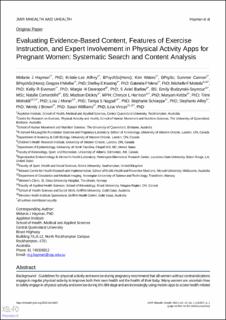| dc.description.abstract | Background: Guidelines for physical activity and exercise during pregnancy recommend that all women without contraindications engage in regular physical activity to improve both their own health and the health of their baby. Many women are uncertain how to safely engage in physical activity and exercise during this life stage and are increasingly using mobile apps to access health-related information. However, the extent to which apps that provide physical activity and exercise advice align with current evidence-based pregnancy recommendations is unclear.
Objective: This study aims to conduct a systematic search and content analysis of apps that promote physical activity and exercise in pregnancy to examine the alignment of the content with current evidence-based recommendations; delivery, format, and features of physical activity and exercise instruction; and credentials of the app developers.
Methods: Systematic searches were conducted in the Australian App Store and Google Play Store in October 2020. Apps were identified using combinations of search terms relevant to pregnancy and exercise or physical activity and screened for inclusion (with a primary focus on physical activity and exercise during pregnancy, free to download or did not require immediate paid subscription, and an average user rating of ≥4 out of 5). Apps were then independently reviewed using an author-designed extraction tool.
Results: Overall, 27 apps were included in this review (Google Play Store: 16/27, 59%, and App Store: 11/27, 41%). Two-thirds of the apps provided some information relating to the frequency, intensity, time, and type principles of exercise; only 11% (3/27) provided this information in line with current evidence-based guidelines. Approximately one-third of the apps provided information about contraindications to exercise during pregnancy and referenced the supporting evidence. None of the apps actively engaged in screening for potential contraindications. Only 15% (4/27) of the apps collected information about the user’s current exercise behaviors, 11% (3/27) allowed users to personalize features relating to their exercise preferences, and a little more than one-third provided information about developer credentials.
Conclusions: Few exercise apps designed for pregnancy aligned with current evidence-based physical activity guidelines. None of the apps screened users for contraindications to physical activity and exercise during pregnancy, and most lacked appropriate personalization features to account for an individual’s characteristics. Few involved qualified experts during the development of the app. There is a need to improve the quality of apps that promote exercise in pregnancy to ensure that women are appropriately supported to engage in exercise and the potential risk of injury, complications, and adverse pregnancy outcomes for both mother and child is minimized. This could be done by providing expert guidance that aligns with current recommendations, introducing screening measures and features that enable personalization and tailoring to individual users, or by developing a recognized system for regulating apps. | en_US |

